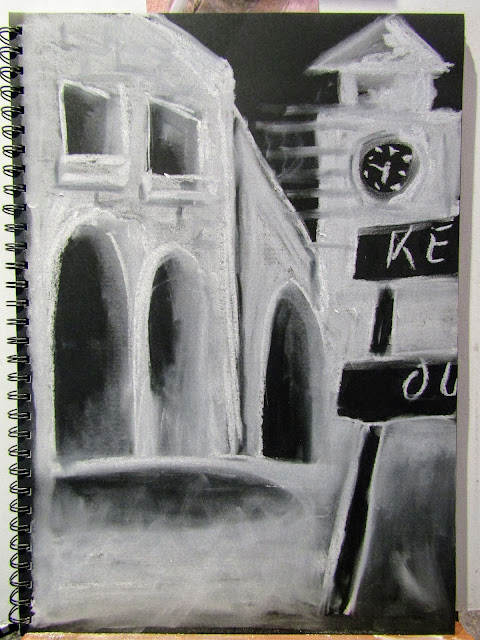Nevertheless, this week, we're learning all about people, or figures - and how to bring them into being. I didn't realise there were so many creative ways to do this. I will share, two of the different ways we experimented with - and they're really, worlds apart.
Experiment #1
One of the exercises, had to do with exploring light and dark tones, specifically through paint. Using a naked model: we could opt for the female image supplied, or find our own. So I opted to find my own image, using a male model instead (above).
It was not my intention to give him, a "Wolverine knives" look to his hands, but I was experimenting with mark making, and trying to distract from the incomplete hands. As he was holding something in both hands, in the reference image. So I had to fudge his hands a little, in order to lose the items.
But then, we later came to do an exercise, which truly excited me...
Experiment #2 begins
This time, we were going to create figures from thin air. We could use a reference image for guidance, if we wanted to - but I was curious to see how I would go, with just my imagination, and the materials I chose.
Personally, I love incorporating newspaper prints in some of my work, through collage. And I found an awesome hand-written letter page, as my base material.
Two random pieces
I tore it up randomly, and started gluing it to my white paper. I had an idea of the figure's position on the page (conjured up in my imagination) but I was also prepared to see what would randomly appear, too.
Six random pieces
I thought this had the good basis for a seated, or crouched position. But at this stage, I still hadn't settled on the final position of the figure. It was still just an idea, forged out of random pieces of paper. Then I started adding the paint...
Acrylic Paint
This, again, was a random process. I liked the rust-coloured look, that yellow-oxide and red, made together. I also thought it complemented the vintage look of the hand-written prints, more than a more bold colour would.
To help in blending and highlighting though, I added a fair bit of white gesso. Ever so gradually, a figure started to emerge...
Titled: "Mc Kenna Replies"
{Mc Kenna, being the surname, written on the envelope}
I decided to keep it more abstract, giving the illusion of a position, without locking it into one. My figure could've been in a crouched position, or standing on one leg.
This is the most abstract, I've gotten in this course. And it didn't make me feel uncomfortable either. Maybe because I didn't have a reference image to compare it to - did I get the proportions right, is the shading correct, etc. This was just a random process, to see what emerged.
I probably could've worked on it more, but I loved the weightless feeling to this painting - a lot more, than the heavy feeling, of the first. I didn't want to lose that, so stopped. I'm definitely going to try more of these.























